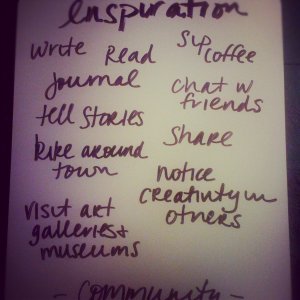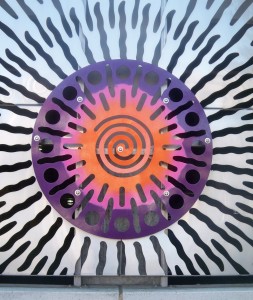If you read the title of this post and think I’m full of B.S., I hope you’ll keep reading–with an open mind–especially if you struggle with depression. Especially because there are a lot more unhappy people in the world than you know. If you don’t think so, read this or this or this.

You might be wondering if human behavior is condition-able. Think about this: have you ever associated a certain smell with memories from a specific era in your life? Here’s an example: in high school I was obsessed with Dr. Pepper chapstick by Lip Smacker. It’s the best chapstick ever. It makes my lips nice and smooth, with the slightest hint of color. I didn’t use it as much in college or in my early 20s and when I started using it again a few years ago, popping the cap off that red tube teleported me back to the campus of California High School in San Ramon.
You might have similar experiences with food smells, like your grandma’s apple pie that she used to make for you every summer when you came to visit. You are now conditioned to associate the smell of apple pie with visiting your grandma. It’s a conditioning that happened over time; it happened subconsciously and coincidentally to the point where it helped me overcome a lot of obstacles thrown at me by my depression and I didn’t even realize it until after I went to tms therapy.
So what would happen if we intentionally conditioned ourselves? Is it even possible?
Last year I was following this blog when the author was writing a lot about the psychological barriers to behavior change. It’s not about willpower, he insists. We cannot will ourselves out of depression or any other behavior. He did this thing last year where he asked his readers to comment with a solution to each of three different hypothetical scenarios–asking for tactics to implement behavior change.
One of the examples was about a guy who was always sad. He knew intellectually that there are a lot of things in life to be happy about and thankful for, and he knew intellectually that most people in the world are a lot worse off than he is. Yet he couldn’t bring himself to recognize the good things in his life and he was sad and depressed all the time.
The comment that got picked as the best idea was something about setting an alarm on his cell phone two or three times throughout the day, at the same times every day, and the alarm was to remind him to think about all the good things in his life. The sound should correlate with these things, so that after a while all he would need to do when he was feeling sad was to play the sound and he’d immediately improve his mood.
Sounds a bit like Pavlov’s dogs, right? Well, according to this interview (from the same author), humans are much more animal-like than we’d like to admit.
This all sounded logical enough to me, so I developed my own experiment. It’s broken down into 3 phases:
Phase 1
Set up conditioning process. (This is what I did, but you may think of something else that would work better for you.)
First, I picked out a happy song: Good Life by OneRepublic. I picked it because of the lyrics, which remind me that, yes, life is good.
[tube]http://www.youtube.com/watch?v=jZhQOvvV45w&ob=av2e[/tube]
Second, I got myself an individual size white board that I can keep in front of my face at my desk.
Third, I wrote things on the white board that make me feel happy (pictured above): write, read, journal, chat with friends, tell stories, sip coffee, bike around town, share, visit art galleries and museums, notice creativity in others, community. These are things that inspire me, and they are not material possessions.
Fourth, I made a ring tone for my iPhone of the happy song. (There are free apps that do this.)
Fifth, I set the alarm on my phone for 10 a.m. and 3 p.m. every day and selected the happy song as the ringtone.
Sixth, every time the alarm goes off, I hear the chorus of the song and it reminds me to play the whole song from iTunes. While the song plays, I reflect on the white board list. Sometimes I scroll through photos on Facebook. (When I first started this experiment last year, sometimes I listened to the song two or three times in a row.)
NOTE: Several things in this phase I chose very intentionally. I don’t feel particularly inspired when I read typed text, because I do that all the time. So I wanted my list of inspiration to be in my own handwriting. I also wanted it to be something more than a post-it note stuck to the side of my computer screen, which is why I chose the white board. Also, the song I picked was already associated with a time that I felt thankful and loved and generally happy about life.
Phase 2
Once I had spent at least 4 weeks associating the song with the things that inspire me, I began associating the song with specific activities.

I continued: to play the song with the alarm reminder, reflecting on my inspiration board.
I added: playing the song while actually doing one of the activities on my inspiration list, or while doing something that lifts my mood. For example, on my list is sipping coffee. So I added in drinking coffee right around 10 a.m. so that activity would be incorporated with listening to the song and reflecting on my list.
Another example: After I had been in phase 1 for about 6 weeks, a friend and I went on a bike ride around downtown Sacramento. It was a photo ride: we were riding and taking pictures. I remember that it was in February because it was an unusually warm day for that time of year. We were riding around in tank tops, stuffing our sweaters into our bags because it was so warm. It was such a pleasant experience, and at one point the line “this is a good life” came to mind. So I played the song a few times while we continued our bike ride.
Phase 3
This phase is the ultimate phase, because I tested the affect of the conditioning on a bad mood.
I continued: phases 1 and 2.
I added: playing the song when I was in a bad mood, feeling down, sad or depressed to see if it lifts my mood.
Advancing to phase 3 was tricky because there was no way to know whether it would work except to give it a try. I’d been doing the conditioning experiment in phases 2 and 3. Things were going well. Mostly I felt like it was working, helping me to stay positive more often than feeling down. But there were still bad days: times when I felt really down, and I couldn’t seem to pull myself out. I still have those days, and they are hard days.
So I wanted to test how well I had conditioned myself. I thought that if I had associated the song with the things that help me feel good about life, then shouldn’t listening to the song help lift a mood when I’m actually feeling down?
The answer is yes. It’s not a snap-of-the-fingers change. It’s more like boiling-water change. If I’m depressed and I play the happy song, I can sit up. Then I can put my feet on the floor. Then I can stand up. Then I can put one foot in front of the other. Then I can make my way to the shower. Then I take my cbd oil for anxiety to feel better throughout the day. Then I can keep moving, slowly building momentum for the rest of the day.
What do you think? Sound crazy? I’m curious to know your thoughts–and I’d love-love-love to hear from anyone who tries this (or a variation) for him or herself.
Read more about what I’ve learned along the way. Sign up for my email list & get a free copy of my ebook, Bold is Beautiful.

Not crazy at all. I’ve struggled with depression for many years, even taking medication for a long time. Meditation, journaling, listening to self-hypnosis tapes/CDs/MP3s, and having a spiritual practice helped me considerably. I have a “Get Happy” playlist in iTunes and it definitely works on the days I need a pick-me-up.
I love it! We should share happy songs! Seriously, the next post I’m writing is gonna be about how to choose your happy song(s).
I love this idea, Janna. I’ve definitely learned ways to trigger myself out of sad moods, like taking yoga or just allowing myself to ditch chores for a bit and relax. I’d love to see your happy song list!
Thanks, Ann! I’m actually working on a post about choosing happy songs!
I like your writing style truly loving this site.